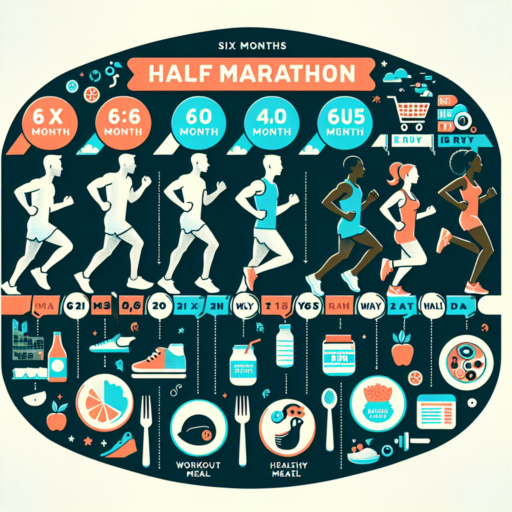How to run 21km in 6 months?
Embarking on the journey to run 21km, or a half marathon, in 6 months is an ambitious goal that is definitely achievable with the right plan and dedication. The key is to start gradually, allowing your body to adjust to the increased physical demands. Whether you are a beginner or have some running experience, the following guidelines are designed to help you safely reach your goal.
Develop a Structured Training Plan
First and foremost, creating a structured training plan is crucial. This plan should gradually increase your mileage over the 6-month period, incorporating rest days to avoid burnout and injuries. Typically, your plan should include three types of runs: long runs to build endurance, speed workouts to improve your pace, and recovery runs to allow your body to heal. Remember, consistency is key; missing too many workouts can set you back significantly.
Incorporate Strength Training and Cross-Training
While running is the focus, integrating strength training and cross-training activities into your routine can significantly enhance your performance and reduce injury risk. Strength training, especially targeted at your core, legs, and glutes, can improve your running economy. Cross-training activities like cycling or swimming can boost cardiovascular health without the pounding impact of running, giving your joints and muscles a deserved break.
Nutrition and Hydration Strategies
Lastly, never underestimate the power of proper nutrition and hydration. Fueling your body with the right nutrients before, during, and after your runs is essential for performance and recovery. Hydration is equally critical; ensure you’re drinking enough water throughout the day and adjust your intake based on the intensity of your workouts and the weather conditions. Incorporating electrolyte-replacement drinks or foods can also aid in maintaining the balance of fluids and electrolytes.
Can I go from couch to half marathon in 6 months?
Embarking on the journey from leading a sedentary lifestyle to running a half marathon in just 6 months is an ambitious goal, yet entirely achievable with the right approach. It’s crucial to understand that moving from the couch to completing a 13.1-mile race requires not only a shift in physical activity but also a strong commitment to changing lifestyle habits and routines. Success hinges on a well-structured training plan that balances gradually increasing distance with adequate rest and recovery.
Initial steps involve assessing your current fitness level to tailor a training plan that suits your needs. For absolute beginners, this might mean starting with walking, progressively integrating running intervals, and eventually transitioning to longer runs. The progression should be gradual to avoid injuries and to build endurance systematically. It’s recommended to follow a training plan that includes three to four runs per week, complemented by cross-training and strength training sessions to support overall fitness and reduce the risk of injury.
Nutrition and Hydration
Maintaining a balanced diet and staying adequately hydrated are pivotal elements that underpin successful training. Nutrition fuels your runs and aids in recovery, whereas hydration is crucial to prevent overheating and maintain optimal performance. Integrating a diet rich in proteins, carbohydrates, healthy fats, and vitamins, along with consistent hydration practices, can significantly impact your training outcome. Listening to your body and adjusting your dietary intake based on your training intensity and duration is crucial.
Moreover, rest and recovery play a fundamental role in any training regimen. Ensuring you allocate enough time for your body to heal and adapt to the increasing demands of training will help in preventing overuse injuries and burnout. The inclusion of rest days, along with techniques such as stretching, foam rolling, and possibly even yoga, can support flexibility and muscle recovery, preparing you for your next training session more effectively.
Can you get marathon fit in 6 months?
Embarking on the journey to becoming marathon fit is a commitment that many runners contemplate. The timeline for achieving this level of fitness can vary greatly depending on several factors, including your current fitness level, running experience, and personal health. However, a six-month period is a commonly cited timeframe that balances ambition with a realistic approach to training and preparation.
Setting Realistic Goals
For beginners, the key to success lies in setting achievable goals. Starting from a base of little to no running experience, six months of dedicated training can dramatically improve your endurance and running efficiency. It’s important to understand the significance of incremental progress, focusing on gradually increasing your weekly mileage while allowing adequate time for recovery to prevent injuries.
Incorporating Varied Training
To optimize your marathon readiness within six months, incorporating a variety of training methods is crucial. This includes long runs to build endurance, speed workouts to improve your pace, and strength training to enhance your overall fitness and resilience. Each component plays a vital role in preparing your body and mind for the rigors of completing a marathon.
Maintaining consistency and monitoring progress throughout your training period is essential to achieving marathon fitness. Balancing intensity with rest and recovery, while also managing nutrition and hydration, are key elements that contribute to a successful marathon training plan. While the path to becoming marathon fit in six months is challenging, it is certainly within reach for those willing to commit to a structured and disciplined training regimen.
No se han encontrado productos.
How many months should you start training for a half marathon?
Training for a half marathon is a journey that requires dedication, perseverance, and a structured plan. The ideal time frame to start training for a half marathon typically ranges between 12 to 16 weeks prior to the event. This period allows a runner, whether a novice or an experienced athlete, to gradually increase their mileage, enhance their endurance, and prepare their body and mind for the rigors of 13.1 miles.
Understanding Your Fitness Level
Before diving into a training schedule, it’s crucial to assess your current fitness level. For those who are new to running, starting with a 16-week training plan might be more beneficial, providing extra weeks to build the foundational mileage without causing undue stress to the body. Conversely, seasoned runners who already have a strong mileage base may find a 12-week program more suitable, focusing on improving speed, stamina, and recovery times.
Key Components of Training
Regardless of the chosen timeframe, a balanced training plan should incorporate a variety of components: gradual mileage increase, cross-training, adequate rest days, and nutrition. Increasing your weekly mileage by no more than 10% is a safe guideline to follow to minimize the risk of injury. Including cross-training activities, such as cycling or swimming, can help build overall strength and reduce the monotony of running. Most importantly, rest days are essential as they allow your body to recover and grow stronger.
Embarking on a half marathon journey is a significant commitment, and the training duration is a critical factor in crossing the finish line successfully. By tailoring your training plan to your personal fitness level and ensuring it includes all key components, you’ll be setting yourself up for a successful and enjoyable race day experience.




